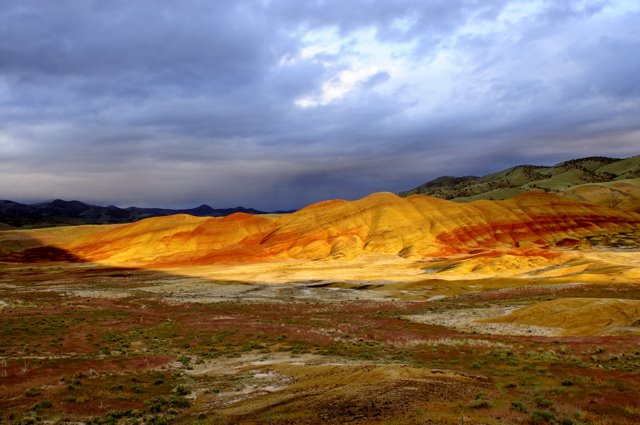Hi,
You are invited to check out my website at: www.dwainspix.com in addition to this blog. You are also welcome and encouraged to add you own comments about either my website or whatever else is on your mind. I just ask that you keep it positive and clean as my grandchildren and other family members will be viewing your comments too.
At www.dwainspix.com you can view and purchase prints of my digital images in various sizes and forms. It will also be the place where I discuss my latest projects and offer tips and suggestions about how to improve your own photography. I hope you find the site informative and useful. Keep and eye on this site as I intend for it to grow in the future.
The picture in the Header was the result of a pile of luck and about 7 hours of patient waiting and watching over a two day period. The clouds finally parted at the very end of my final day at the Painted Hills of the John Day Fossil Beds National Monument. A single beam of sunlight made it through to light only the hills and lasted a total of one and a half minutes. This was one of the first landscapes I captured with my new Nikon D300 and I was very lucky to get the chance. There were no other photographers there at the time as they had all left about an hour earlier. I had been watching the clouds and it looked like the one tiny opening in them just might align itself jusf as the sun hit the horizon. It did!
Thursday, May 28, 2009
My Photography Blog
Labels:
digital images,
dwainspix website,
greeting cards,
landscapes,
Pictures,
prints,
seascapes,
website
Subscribe to:
Post Comments (Atom)
Photography Tips
Here are a few things you can do to improve your photography that will apply regardless of what camera you use. These are the basics that every photographer should know and do to get reasonably good pictures out of any camera.
Make sure you have a clean lens. Don't just blow the dust off, but use a clean cloth suitable for cleaning lenses and do it right.
Set up so your camera is stable and won't move as you press the shutter. You can do this a number of ways. If you will be handholding the camera, hold your elbows in against your sides, and stand with your feet apart with one slightly forward of the other. You can also lean against a solid object like a light pole, tree, building or whatever. The best method though is to use a tripod or monopod. I have both but I like to carry the tripod best. If I want to use it as a monopod I just extend only one leg and us it as I would a monopod. I'll add instructions about to how to use these tools later.
Finally the "First" basic thing you need to do is read your manual and learn what all the parts of your camera are for and how to use them. If you understand how your meter works and what white balence is you'll go a long way to getting that shot you want when the light is wierd and you are wondering why your pictures are all dark or yellow instead of like what you saw on the monitor or in the viewfinder.
I'll expand on all these topics in the coming weeks and months so you'll want to check back and see what I've added from time to time.
Make sure you have a clean lens. Don't just blow the dust off, but use a clean cloth suitable for cleaning lenses and do it right.
Set up so your camera is stable and won't move as you press the shutter. You can do this a number of ways. If you will be handholding the camera, hold your elbows in against your sides, and stand with your feet apart with one slightly forward of the other. You can also lean against a solid object like a light pole, tree, building or whatever. The best method though is to use a tripod or monopod. I have both but I like to carry the tripod best. If I want to use it as a monopod I just extend only one leg and us it as I would a monopod. I'll add instructions about to how to use these tools later.
Finally the "First" basic thing you need to do is read your manual and learn what all the parts of your camera are for and how to use them. If you understand how your meter works and what white balence is you'll go a long way to getting that shot you want when the light is wierd and you are wondering why your pictures are all dark or yellow instead of like what you saw on the monitor or in the viewfinder.
I'll expand on all these topics in the coming weeks and months so you'll want to check back and see what I've added from time to time.

No comments:
Post a Comment